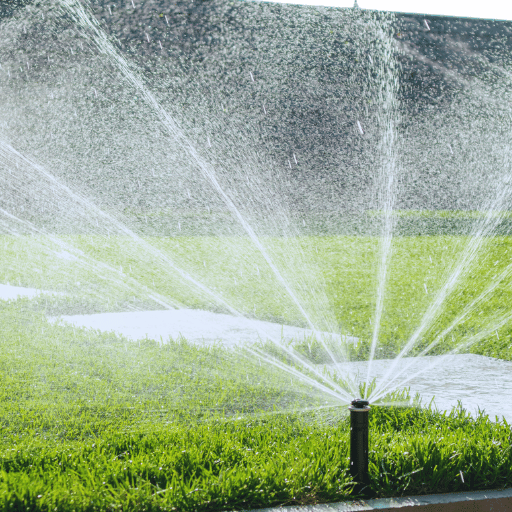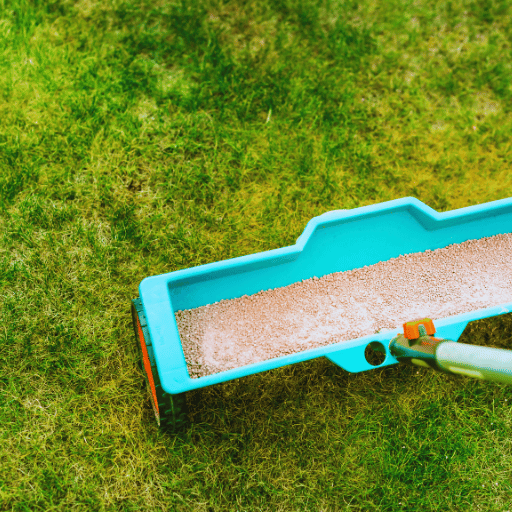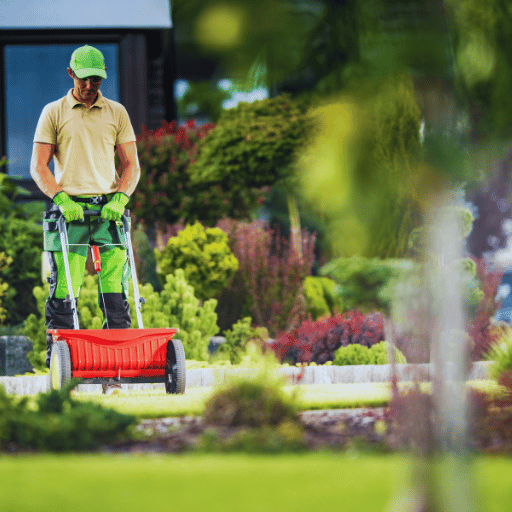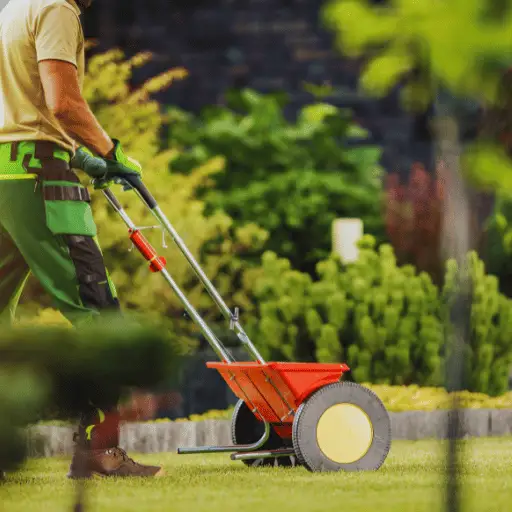The question of “can you put fertiliser on wet grass” is a common one among gardeners and lawn enthusiasts. Many people wonder if fertilising wet grass is beneficial or potentially harmful, leading to confusion and varied opinions on the subject.
Why the Question Matters
Fertilising your lawn is an essential part of maintaining healthy, green grass, but doing it incorrectly can result in poor results or even damage. Addressing whether it’s safe and effective to fertilise wet grass helps clear up common misconceptions, ensuring that your lawn receives the nutrients it needs without causing unnecessary harm.
How Fertilisers Work
Fertilisers are designed to provide essential nutrients such as nitrogen (N), phosphorus (P), and potassium (K) to the soil, which the grass absorbs through its roots. These nutrients promote growth, enhance colour, and strengthen the grass against diseases and pests. For fertilisers to work effectively, they need to be absorbed into the soil, where they can reach the root system.
Is It Possible?
Yes, you can put fertiliser on wet grass, but several factors influence its effectiveness. The moisture can actually aid in the absorption process, helping the fertiliser dissolve and penetrate the soil more efficiently. However, it’s crucial to understand that certain conditions, such as heavy rain or excessive moisture, can also lead to problems like nutrient runoff or uneven distribution.
The Science Behind Fertilising Wet Grass
How Moisture Affects Fertiliser Absorption
Moisture plays a significant role in how effectively fertilisers are absorbed by grass. When grass is wet, the fertiliser granules dissolve more easily, allowing the nutrients to seep into the soil and reach the root system. This process enhances the fertiliser’s ability to nourish the grass and promotes faster absorption compared to when applied on dry soil.
According to Dr. Mark Williams, an agronomist, “Applying fertiliser to wet grass can facilitate nutrient uptake, as moisture helps dissolve the fertiliser, making it more accessible to the plant roots.”
Solubility of Fertilisers
The solubility of fertiliser is crucial for its effectiveness. Most fertilisers are designed to dissolve in water, which is why moisture aids in nutrient absorption. When applied to wet grass, the fertiliser dissolves quickly and penetrates the soil, ensuring that essential nutrients such as nitrogen, phosphorus, and potassium are readily available to the grass roots. This process is particularly effective with water-soluble fertilisers, which are specifically designed to be absorbed more efficiently in moist conditions.
Potential Risks of Fertilising Wet Grass
While fertilising wet grass can enhance nutrient absorption, there are some potential risks to consider:
- Over-fertilisation: Wet grass can sometimes cause fertiliser to stick to the blades, leading to over-application in certain areas. This can result in nutrient imbalances or even grass burn if the fertiliser isn’t distributed evenly.
- Runoff: If the ground is already saturated, fertiliser applied to wet grass can wash away, especially after heavy rain. This not only wastes product but can also contribute to environmental pollution by contaminating nearby water sources.
- Potential Damage: Certain types of fertilisers, especially those with high nitrogen content, can cause damage if they remain on wet grass blades for too long without being absorbed.
Understanding these factors helps in making informed decisions about fertilising wet grass, ensuring that you achieve the best results while minimising potential risks.
The Pros of Fertilising Wet Grass
Better Nutrient Absorption
One of the main advantages of fertilising wet grass is that it allows for better nutrient absorption. When the grass is already wet, the fertiliser granules dissolve quickly, making it easier for nutrients to penetrate the soil and reach the grass roots. This process ensures that the grass gets the nutrients it needs faster, leading to quicker and more noticeable results. According to lawn care expert David Miller, “Applying fertiliser to wet grass can be more effective because the moisture helps carry the nutrients directly to the roots, accelerating the fertilisation process.
Reduced Risk of Fertiliser Burn
Fertiliser burn is a common issue that occurs when too much fertiliser is applied, causing the grass blades to scorch and turn brown. When grass is wet, there’s a lower risk of fertiliser burn because the moisture dilutes the fertiliser, preventing it from being too concentrated in one area. This dilution effect helps distribute the nutrients more evenly across the lawn, reducing the chances of damaging your grass.
Ideal for Slow-Release Fertilisers
Slow-release fertilisers are designed to provide nutrients to the lawn over an extended period, ensuring a steady supply without overwhelming the grass. Applying slow-release fertiliser to wet grass can be particularly effective, as the moisture helps to activate the fertiliser while allowing it to break down gradually. This ensures that your lawn receives a consistent nutrient supply, leading to healthier, greener grass over time.
The Cons of Fertilising Wet Grass
Risk of Fertiliser Runoff
One of the most significant drawbacks of fertilising wet grass is the potential for fertiliser runoff. When the soil is already saturated, or if there’s heavy rainfall soon after application, the fertiliser can be washed away before it has a chance to be absorbed. This not only wastes the fertiliser but also poses an environmental hazard. Runoff can carry chemicals into nearby water bodies, contributing to water pollution and issues like algal blooms. Environmental scientist Dr. Susan Collins warns, “Runoff from over-fertilisation is a leading cause of nutrient pollution in rivers and lakes, which can have detrimental effects on aquatic ecosystems.”
Uneven Distribution
Applying fertiliser to wet grass can make it challenging to achieve even coverage. Wet grass blades can cause the fertiliser granules to clump together, leading to patchy growth where some areas receive more nutrients than others. This uneven distribution can result in a lawn that appears inconsistent, with some spots growing faster and healthier while others lag behind.
Potential Lawn Damage
Fertilising wet grass, particularly with a high-nitrogen fertiliser, can cause damage if the fertiliser remains on the grass blades for too long. The moisture can cause the fertiliser to stick to the blades, leading to burning or scorching as the concentrated chemicals come into direct contact with the grass. This is more likely to happen if fertiliser is applied during extremely wet conditions or if the lawn is not watered adequately afterward to wash the fertiliser into the soil.
These cons highlight the importance of timing and technique when fertilising wet grass to avoid potential pitfalls.

When is the Best Time to Fertilise Wet Grass?
Ideal Weather Conditions
The best time to fertilise wet grass is during periods of mild, damp weather, such as after a light rain or when there’s a layer of early morning dew. These conditions ensure that the grass is moist, which aids in fertiliser absorption, but not so saturated that it risks runoff. Applying fertiliser on a slightly damp lawn allows the nutrients to dissolve and penetrate the soil effectively, without the risk of the granules sticking to the grass blades.
According to lawn care specialist Mark Taylor, “Fertilising after a light rain or during periods of light morning dew offers the perfect balance of moisture, ensuring the fertiliser is absorbed efficiently without being washed away.”
Seasonal Considerations
The best time of year to fertilise wet grass depends on your grass type and climate:
- Cool-season grasses (e.g., fescue, bluegrass, ryegrass): The ideal time to fertilise is in the early spring or autumn, as these grasses experience their peak growth during cooler weather.
- Warm-season grasses (e.g., Bermuda, zoysia, St. Augustine): Fertilise in late spring through early summer, when these grasses are actively growing.
Avoid fertilising wet grass during extremely hot summer months or freezing winter conditions, as these temperatures can either cause nutrient evaporation or prevent proper absorption.
Avoiding Heavy Rain
It’s crucial to avoid fertilising just before or during heavy rainfall. Excess rain can cause the fertiliser to wash away, leading to nutrient runoff and environmental pollution. Always check the weather forecast before applying fertiliser, and aim for a day when there’s no heavy rain expected for at least 24 hours.
Types of Fertilisers Suitable for Wet Grass
Water-Soluble vs. Granular Fertilisers
When it comes to fertilising wet grass, both water-soluble and granular fertilisers have their advantages and disadvantages:
- Water-Soluble Fertilisers: These fertilisers dissolve quickly in water, making them ideal for use on wet grass. The nutrients are immediately available to the grass roots, leading to faster results. However, they can be more prone to runoff if applied during heavy rainfall or if the grass is overly saturated.
- Granular Fertilisers: Granular fertilisers are slower to dissolve, making them more suitable for long-term nutrient release. While they work well on wet grass, it’s essential to ensure the grass isn’t too wet, as this can cause the granules to clump together, leading to uneven distribution.
Slow-Release Fertilisers
Slow-release fertilisers are an excellent choice for fertilising wet grass. These fertilisers release nutrients gradually over time, ensuring a steady nutrient supply without overwhelming the grass. The moisture on the grass blades helps activate the slow-release mechanism, allowing the fertiliser to break down slowly and provide consistent nourishment.
Organic vs. Synthetic Options
- Organic Fertilisers: Made from natural ingredients such as compost, bone meal, or manure, organic fertilisers are generally more forgiving when applied to wet grass. They’re less likely to cause fertiliser burn or runoff and improve soil health over time. However, they release nutrients more slowly than synthetic options.
- Synthetic Fertilisers: These fertilisers are formulated to provide a precise balance of nutrients. While they can be highly effective on wet grass, they require more caution to avoid over-fertilisation or potential damage, especially if the grass is very wet.

How to Apply Fertiliser on Wet Grass Safely
Step-by-Step Guide
- Choose the Right Fertiliser: Select a fertiliser that suits your grass type and lawn needs. For wet grass, slow-release or organic fertilisers are often the best choice to prevent nutrient overload.
- Check the Weather: Ensure there’s no heavy rain forecast for the next 24-48 hours. This will prevent the fertiliser from being washed away before it has a chance to be absorbed.
- Prepare Your Lawn: Lightly mow your lawn and remove any debris to ensure even fertiliser distribution. Wet grass should be damp, not soaked, to avoid clumping or runoff.
- Apply the Fertiliser Evenly: Use a broadcast spreader for granular fertiliser or a watering can for water-soluble fertiliser. Start at one end of your lawn and move methodically to ensure even coverage, overlapping slightly with each pass.
- Water Lightly (if needed): If your grass isn’t thoroughly wet, lightly water the lawn to help dissolve the fertiliser granules and carry nutrients into the soil. Avoid overwatering, as this can lead to runoff.
Safety Precautions
- Wear Protective Gear: Always wear gloves, long sleeves, and closed-toe shoes to protect your skin from direct contact with fertiliser.
- Avoid Contact with the Grass Blades: Be cautious not to over-apply fertiliser on wet grass blades, as this can cause fertiliser burn.
- Keep Children and Pets Off the Lawn: Allow the fertiliser to settle and the grass to dry before allowing anyone to walk on it.
Monitoring Grass Health
After fertilising, monitor your lawn for any signs of over-fertilisation, such as yellowing, wilting, or browning. If you notice these symptoms, water your lawn thoroughly to help wash away excess fertiliser and dilute the concentration.
Common Mistakes to Avoid When Fertilising Wet Grass
1. Over-Applying Fertiliser
One of the most common mistakes is over-applying fertiliser on wet grass. Applying too much can lead to nutrient imbalances, cause fertiliser burn, or even kill patches of grass. Always measure the recommended amount and avoid the temptation to apply extra, thinking it will yield better results.
2. Ignoring Weather Forecasts
Fertilising just before or during heavy rainfall can result in the fertiliser being washed away, leading to waste and potential environmental harm. Always check the weather forecast before applying fertiliser and choose a time when there’s no heavy rain expected for at least 24-48 hours.
3. Not Following Label Instructions
Each fertiliser product has specific instructions regarding application rates and methods. Failing to follow label instructions can lead to over-fertilisation, nutrient deficiencies, or even damage to your lawn. Carefully read and adhere to the guidelines provided for the best results.
4. Applying Fertiliser to Extremely Wet Grass
Applying fertiliser to grass that is excessively wet or saturated can cause the granules to clump together, leading to uneven distribution. It’s important to wait until the grass is damp but not dripping wet to ensure the fertiliser spreads evenly.
5. Using the Wrong Type of Fertiliser
Choosing a fertiliser that’s not suited for wet grass or your specific lawn type can lead to poor results or potential damage. Opt for slow-release or water-soluble fertilisers that are designed to work well in moist conditions.
By avoiding these common mistakes, you can ensure your lawn benefits fully from fertilising without the risk of damage.

Expert Opinions: What Do Lawn Care Specialists Say About Fertilising Wet Grass?
Insights from Lawn Care Professionals
Lawn care specialist Jennifer Green suggests, “Fertilising wet grass can be effective, especially when using slow-release fertilisers. The moisture helps dissolve the fertiliser granules, allowing nutrients to reach the soil faster. However, it’s crucial to avoid over-fertilising, as wet conditions can sometimes amplify the effects of fertiliser.”
John Miller, a professional groundskeeper with over 20 years of experience, advises, “The best time to fertilise wet grass is early in the morning when there’s dew on the ground. This ensures the grass is moist but not soaked, providing the perfect environment for fertiliser absorption.”
Real-World Experiences
Sarah Thompson, a gardening enthusiast, shared her success with fertilising wet grass: “After fertilising my lawn following a light rain, I noticed a significant improvement in grass growth and colour within just two weeks. The moisture helped the fertiliser break down quickly, leading to healthier, greener grass.”
Similarly, a landscape maintenance company reported that using slow-release fertilisers on damp grass resulted in more even growth and fewer instances of fertiliser burn compared to when they applied fertiliser to dry grass.
Recommendations for Optimal Fertilisation
Experts recommend:
- Fertilising when grass is damp but not waterlogged, ideally after a light rain or morning dew.
- Using slow-release or organic fertilisers to minimise the risk of burning and ensure a consistent nutrient supply.
- Always following label instructions and conducting a soil test before fertilising to avoid nutrient imbalances.
By incorporating these expert insights, you can optimise your fertilisation practices and maintain a healthy, lush lawn.
FAQ: Can You Put Fertiliser on Wet Grass?
1. Can you put fertiliser on wet grass?
Yes, you can put fertiliser on wet grass, and in some cases, it can be beneficial. The moisture helps the fertiliser dissolve, allowing nutrients to penetrate the soil more effectively. However, it’s essential to avoid fertilising grass that is overly saturated or during heavy rain, as this can cause runoff and waste.
2. Is it better to fertilise grass when it’s wet or dry?
Fertilising slightly damp grass, such as after a light rain or morning dew, can be more effective, as the moisture helps the fertiliser dissolve and absorb into the soil. However, avoid fertilising when the grass is excessively wet, as this can lead to uneven distribution or nutrient runoff.
3. What type of fertiliser is best for wet grass?
Slow-release fertilisers and water-soluble fertilisers are ideal for wet grass, as they dissolve more easily and provide a consistent supply of nutrients. Organic fertilisers are also suitable, as they’re less likely to cause fertiliser burn when applied to wet grass.
4. Can fertilising wet grass cause fertiliser burn?
Fertiliser burn is less likely when applying fertiliser to wet grass, as the moisture helps dilute the fertiliser and prevents it from being too concentrated. However, over-applying fertiliser or using a high-nitrogen formula can still cause damage, even on wet grass.
5. How do I avoid fertiliser runoff when applying fertiliser to wet grass?
To avoid runoff, make sure you apply fertiliser when the grass is damp but not waterlogged. Avoid fertilising before heavy rain and always follow the recommended application rates to prevent excess fertiliser from being washed away.
6. When is the best time to fertilise wet grass?
The best time to fertilise wet grass is early in the morning when there’s dew on the ground or after a light rain. This ensures the grass is moist enough to aid fertiliser absorption but not so wet that it risks runoff or uneven distribution.
7. Can I fertilise my lawn before it rains?
You can fertilise your lawn before a light rain, as this helps the fertiliser dissolve and absorb into the soil. However, avoid fertilising before heavy rain, as it can wash away the fertiliser and reduce its effectiveness.
8. Should I water my lawn after fertilising wet grass?
If your grass is already wet or damp, there’s usually no need to water it again after fertilising. However, if the grass begins to dry out, lightly watering the lawn can help the fertiliser dissolve and absorb into the soil more effectively.
9. Is it okay to fertilise newly seeded or sodded lawns when they are wet?
Yes, you can fertilise newly seeded or sodded lawns when they are damp, as this promotes quicker root establishment. Just be cautious with the amount of fertiliser applied, as young grass can be more sensitive to over-fertilisation.







